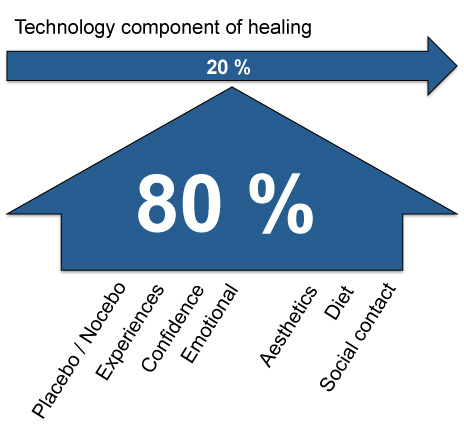
Even the millennia-generation must realize that the baby boomers have finally reached retirement. The past century of medical progress insured decades of unprecedented healthy and active retirement lives for the largest generation the world has ever seen. The question then remains how to finance care for our parents while investing in the future of our children and how to create a viable system at both ends.
In Denmark, the medical establishment is undergoing the largest transformation in the county's 1,200-year history in order to meet the needs of their baby boomer generation. This process requires commitment and lots of creativity and a national challenge on this scale has not been experienced since the construction of the Danish Christian churches in the eleven hundreds. Over the next five to 10 years, the country is planning 11 super-hospitals as well as an upgrading of the existing hospital and health care system. The entire approach to health and wellbeing is being reframed and redesigned from the ground up.
Anders Smith is the industrial designer supporting this huge challenge with decades of national as well as international experience stretching from consumer electronics to medical equipment design. On a recent design quantification research project, we had the opportunity to learn from him about the amazing opportunities design has uncovered about humans and their health. Here is some of what he shared.
Being sick is stressful enough, and peace of mind is needed to recuperate. Yet, 80 percent of all patient recovery depends on non-technical aspects, and positive psychology can count for as much as 20 percent of patient healing. For example, it is now known that limiting the use of medication helps patients recoup from surgery faster.[2] Medical research and experiences from Cleveland Hospital, confirm that wellness is best served when considered holistically and physical health, to a large extent, is influenced by social wellbeing and one's outlook on life.[3] In the circle of life, individual wellbeing is influenced by the wellbeing of family and friends, extending out to their family and friends. So when a patient has visitors, they bring more than roses and chocolates, they can also bring the worries of their friends and that can have an affect on the patient's health, as well.
Many can relate to having had a hospital experience reminiscent of sleeping in the middle of New York's Grand Central Station. Foot traffic is intense and in a 24-hour period you might be interrupted by somebody emptying your trash and cleaning, yet another bringing medicine, someone new taking your vital signs, another face changing sheets, yet another taking you potty, a new person getting you washed, a fresh person bringing you food, a social worker having you fill out a questionnaire and so forth. With a three-shift team, you can easily interact with 30 people and be interrupted every half hour, day and night. In fact, you really have to be very healthy to survive in today's high stress hospital environment.
The next generation of super hospitals will focus much more on patient care, intelligently facilitating the lives of patients, relatives, nurses, doctors as well as the administration. Hospitals will be designed with everybody's health in mind. Each room, hallway and suite will be installed with intelligent light, sound, animation and heating systems, changing the environment to adjust to the time of day and year, anticipating and accommodating the needs of the occupants. The intelligent environment system will provide the patients quiet time alone to help them rest, sleep and recoup. Only if a medical emergency occurs, will the local environment shift to operational mode. Effectively managing energy could reduce the energy costs of running a hospital by up to 30 percent.[4]
How can we afford all this? Studies show that patients enjoying a room with beautiful view leave hospitals 30 percent faster than the patients staring at a brick wall.[5] Better care also substantially decreases the risk of many patients quickly returning to the hospital. At a cost of $2,200 a day per hospital bed, a short payback time on these changes is expected. Still, the overall benefit of these changes is to the patients themselves because when patients see themselves as guests rather than sick people, their beliefs, attitudes and behaviors change and this tends to greatly advance their bodies own ability to heal itself, which, amazingly enough, is what really happens.
For more by Soren Petersen, click here.
For more on personal health, click here.
References:
[1], [2], [3], [5] Jone Geimer-Flanders, "Creating a Healing Environment: Rationale and Research Overview." The Cleveland Clinic Foundation, 2009.
[4] Carlo Volf, "Computer- Og Dagslysstyret Belysning Pa Hospitaler (Computer and Daylight-Controlled Lighting at Hospitals)." 2009.
?
Follow Soren Petersen on Twitter: www.twitter.com/soreningomar
2012 ncaa tournament bracket matterhorn chris harrison braveheart girl scouts printable bracket armenian genocide
No comments:
Post a Comment
Note: Only a member of this blog may post a comment.